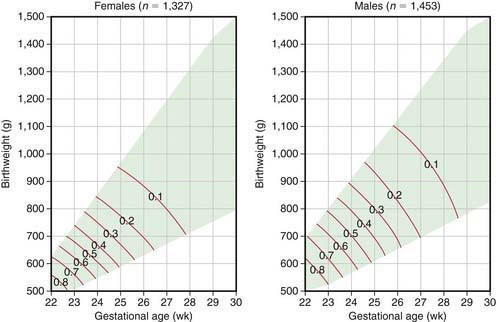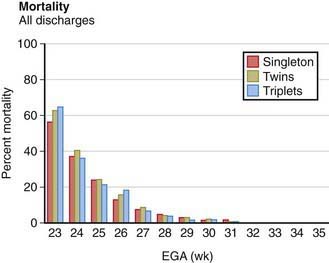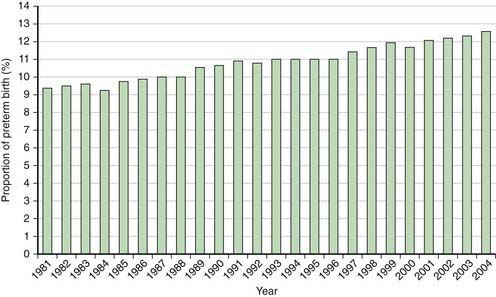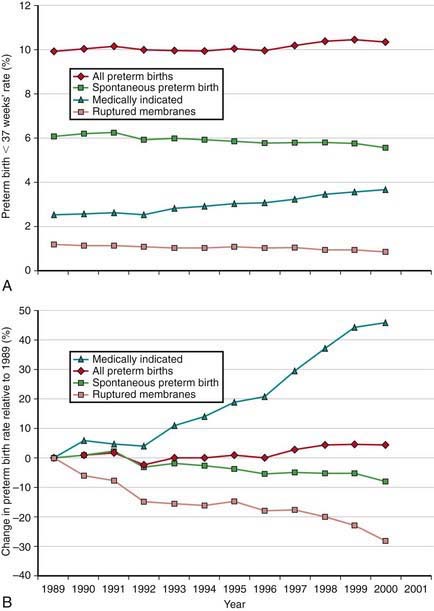Chapter 91 The High-Risk Infant
Neonates at risk should be identified as early as possible to decrease neonatal morbidity and mortality (Chapter 87). The term high-risk infant designates an infant who should be under close observation by experienced physicians and nurses. Factors that define infants as being high-risk are listed in Table 91-1. Approximately 9% of all births require special or neonatal intensive care. Usually needed for only a few days, such observation may last from a few hours to several months. Some institutions find it advantageous to provide a special or transitional care nursery for high-risk infants, often within the labor and delivery suite. This facility should be equipped and staffed like a neonatal intensive care area.
DEMOGRAPHIC SOCIAL FACTORS
PAST MEDICAL HISTORY
PREVIOUS PREGNANCY
PRESENT PREGNANCY
LABOR AND DELIVERY
NEONATE
Examination of the fresh placenta, cord, and membranes may alert the physician to a newborn infant at high risk and may help confirm a diagnosis in a sick infant. Fetal blood loss may be indicated by placental pallor, retroplacental hematoma, and tears in the velamentous cords or chorionic blood vessels supplying the succenturiate lobes. Placental edema and secondary possible immunoglobulin G deficiency in a newborn may be associated with fetofetal transfusion syndrome, hydrops fetalis, congenital nephrosis, or hepatic disease. Amnion nodosum (granules on the amnion) and oligohydramnios are associated with pulmonary hypoplasia and renal agenesis, whereas small whitish nodules on the cord suggest a candidal infection. Short cords and noncoiled cords occur with chromosome abnormalities and omphalocele. True umbilical cord knots are seen in approximately 1% of births and are associated with a long cord, small fetal size, polyhydramnios, monoamniotic twinning, fetal demise, and low Apgar scores.
Chorioangiomas are associated with prematurity, abruptio placentae, polyhydramnios, and intrauterine growth restriction (IUGR). Meconium staining suggests in utero stress, and opacity of the fetal surface of the placenta suggests infection. Single umbilical arteries are associated with an increased incidence of congenital renal abnormalities and syndromes.
For many infants who are born prematurely, are small for gestational age (SGA), have significant perinatal asphyxia, are breech, or are born with life-threatening congenital anomalies, there are no previously identified risk factors. For any given duration of gestation, the lower the birthweight, the higher the neonatal mortality; for any given birthweight, the shorter the gestational duration, the higher the neonatal mortality (Fig. 91-1). The highest risk of neonatal mortality occurs in infants who weigh <1,000 g at birth and whose gestation was <28 wk. The lowest risk of neonatal mortality occurs in infants with a birthweight of 3,000-4,000 g and a gestational age of 38-42 wk. As birthweight increases from 500 to 3,000 g, a logarithmic decrease in neonatal mortality occurs; for every week of increase in gestational age from the 25th to the 37th wk, the neonatal mortality rate decreases by approximately half. Nevertheless, approximately 40% of all perinatal deaths occur after 37 wk of gestation in infants weighing 2,500 g or more; many of these deaths take place in the period immediately before birth and are more readily preventable than those of smaller and more immature infants. Neonatal mortality rates rise sharply for infants weighing over 4,000 g at birth and for those whose gestational period is 42 wk or longer. Because neonatal mortality largely depends on birthweight and gestational age, Figure 91-1 can be used to help identify high-risk infants quickly. This analysis is based on total live births and therefore describes the mortality risk only at birth. Because most neonatal mortality occurs within the 1st hours and days after birth, the outlook improves dramatically with increasing postnatal survival.

Figure 91-1 Estimated mortality risk by birthweight and gestational age based on singleton infants in National Institute of Child Health and Human Development (NICHD) Neonatal Research Network centers between January 1, 1995, and December 31, 1996.
(From Lemons JA, Bauers CR, Oh W, et al: Very low birthweight outcomes of the National Institute of Child Health and Human Development Neonatal Research Network, January 1995 through December 1996, Pediatrics 107:2001; available at www.pediatrics.org.cgi/content/full/107/1/el.)
91.1 Multiple Gestation Pregnancies
Incidence
The reported incidence of spontaneous twinning is highest among blacks and East Indians, followed by northern European whites, and is lowest in the Asian races. Specific rates are 1/56 in Belgium, 1/70 among American blacks, 1/86 in Italy, 1/88 among American whites, 1/130 in Greece, 1/150 in Japan, and 1/300 in China. Differences in the incidence of twins mainly involve fraternal (polyovular) dizygotic twins. Triplets are estimated to occur in 1 in 862 pregnancies and quadruplets in 1 in 863 pregnancies in the USA. The incidence of monozygotic twins (3-5/1,000) is unaffected by racial or familial factors. The incidence of twins detected by ultrasonography at 12 wk of gestation (3-5%) is much higher than that occurring later in pregnancy; the vanishing twin syndrome results in a singleton fetus. Although the incidence of spontaneous multifetal gestation has been stable over the years, the overall incidence of multifetal gestation is increasing as a result of treatment of infertility with ovarian stimulants (clomiphene, gonadotropins) and in vitro fertilization. Twins account for about 2.5% of births but about 20% of very low birthweight (VLBW) infants.
Etiology
The occurrence of monovular twins appears to be independent of genetic influence. Polyovular pregnancies are more frequent beyond the 2nd pregnancy, in older women, and in families with a history of polyovular twins. They may result from simultaneous maturation of multiple ovarian follicles, but follicles containing two ova have been described as a genetic trait leading to twin pregnancies. Twin-prone women have higher levels of gonadotropin. Polyovular pregnancies occur in many women treated for infertility.
Conjoined twins (Siamese twins—incidence 1/50,000) probably result from relatively late monovular separation, as does the presence of two separate embryos in one amniotic sac. The latter condition has a high fatality rate owing to obstruction of the circulation secondary to intertwining of the umbilical cords. The prognosis for conjoined twins depends on the possibility of surgical separation, which in turn depends on the extent to which vital organs are shared. The site of connections varies: thoraco-omphalopagus (28% of conjoined twins), thoracopagus (18%), omphalopagus (10%), craniopagus (6%), and incomplete duplication (10%). Difficult-to-separate conjoined twins have occasionally survived to adulthood. Most conjoined twins are female.
Superfecundation, or fertilization of an ovum by an insemination that takes place after one ovum has already been fertilized, and superfetation, or fertilization and subsequent development of an embryo when a fetus is already present in the uterus, have been proposed as uncommon explanations for differences in size and appearance of certain twins at birth.
A prenatal diagnosis of pregnancy with twins is suggested by a uterine size that is greater than that expected for gestational age, auscultation of two fetal hearts, and elevated maternal serum α-fetoprotein or human chorionic gonadotropin levels, and it is confirmed by ultrasonography. Ninety percent of twins are detected before delivery.
Monozygotic Versus Dizygotic Twins
Identifying twins as monozygotic or dizygotic (monovular or polyovular) is important because studying monozygotic twins is useful in determining the relative influence of heredity and environment on human development and disease. Twins of widely discrepant size are usually monochorionic. Twins not of the same sex are dizygotic. In twins of the same sex, zygosity should be determined and recorded at birth through careful examination of the placenta. Detailed blood typing, gene analysis, or tissue (HLA) typing can also be used to determine zygosity. Monozygotic twins may have physical and cognitive differences because their in utero environment may be different; differences may exist in the mitochondrial genome, in post-translational gene product modification, and in the epigenetic modification of nuclear genes in response to environmental factors.
Examination of the Placenta
If the placentas are separate, they are always dichorionic (present in 75%), but the twins are not necessarily dizygotic, because initiation of monovular twinning at the 1st cell division or during the morula stage may result in two amnions, two chorions, and even two placentas. One third of monozygotic twins are dichorionic and diamnionic.
An apparently single placenta may be present with either monovular or polyovular twins; yet inspection of a polyovular placenta usually reveals that each twin has a separate chorion that crosses the placenta between the attachments of the cords and two amnions. Separate or fused dichorionic placentas may be disproportionate in size. The fetus attached to the smaller placenta or the smaller portion of the placenta is usually smaller than its twin or is malformed. Monochorionic twins may be presumed to be monovular. They are usually diamnionic, and almost invariably, the placenta is a single mass.
Problems of twin gestation include polyhydramnios, hyperemesis gravidarum, preeclampsia, premature rupture of membranes, vasa previa, velamentous insertion of the umbilical cord, abnormal presentations (breech), and premature labor. When compared with the first-born twin, the 2nd twin is at increased risk for respiratory distress syndrome and asphyxia. Twins are at risk for IUGR, twin-twin transfusion, and congenital anomalies, which occur predominantly in monozygotic twins. Anomalies are due to compression deformation of the uterus from crowding (hip dislocation), vascular communication with embolization (ileal atresia, porencephaly, cutis aplasia) or without embolization (acardiac twin), and unknown factors that cause twinning (conjoined twins, anencephaly, meningomyelocele).
Placental vascular anastomoses occur with high frequency only in monochorionic twins. In monochorionic placentas, the fetal vasculature is usually joined, sometimes in a very complex manner. The vascular anastomoses in monochorionic placentas may be artery to artery, vein to vein, or artery to vein. They are usually balanced so that neither twin suffers. Artery-to-artery communications cross over placental veins, and when anastomoses are present, blood can readily be stroked from one fetal vascular bed to the other. Vein-to-vein communications are similarly recognized but are less common. A combination of artery-to-artery and vein-to-vein anastomoses is associated with the condition of acardiac fetus. This rare lethal anomaly (1/35,000) is secondary to the TRAP (twin reversed arterial perfusion) syndrome—In utero neodynium:yttrium-aluminum-garnet (Nd:YAG) laser ablation of the anastomosis or cord occlusion can be used to treat heart failure in the surviving twin. In rare cases, one umbilical cord may arise from the other after leaving the placenta. In such cases, the twin attached to the secondary cord usually is malformed or dies in utero.
In the fetal transfusion syndrome, an artery from one twin acutely or chronically delivers blood that is drained into the vein of the other. The latter becomes plethoric and large, and the former is anemic and small. Generally, with chronicity, 5 g/dL hemoglobin and 20% body weight differences can be noted in this syndrome. Maternal hydramnios in a twin pregnancy suggests fetal transfusion syndrome. Anticipating this possibility by preparing to transfuse the donor twin or bleed the recipient twin may be lifesaving. Death of the donor twin in utero may result in generalized fibrin thrombi in the smaller arterioles of the recipient twin, possibly as the result of transfusion of thromboplastin-rich blood from the macerating donor fetus. Disseminated intravascular coagulation may develop in the surviving twin. Table 91-2 lists the more frequent changes associated with a large uncompensated arteriovenous shunt from the placenta of one twin to that of the other. Treatment of this highly lethal problem includes maternal digoxin, aggressive amnioreduction for polyhydramnios, selective twin termination, and Nd:YAG laser or fetoscopic ablation of the anastomosis.
Table 91-2 CHARACTERISTIC CHANGES IN MONOCHORIONIC TWINS WITH UNCOMPENSATED PLACENTAL ARTERIOVENOUS SHUNTS
| TWIN ON | |
|---|---|
| ARTERIAL SIDE—DONOR | VENOUS SIDE—RECIPIENT |
| Prematurity | Prematurity |
| Oligohydramnios | Polyhydramnios |
| Small premature | Hydrops |
| Malnourished | Large premature |
| Pale | Well nourished |
| Anemic | Plethoric |
| Hypovolemia | Polycythemic |
| Hypoglycemia | Hypervolemic |
| Microcardia | Cardiac hypertrophy |
| Glomeruli small or normal | Myocardial dysfunction |
| Arterioles thin walled | Tricuspid valve regurgitation |
| Right ventricular outflow obstruction | |
| Glomeruli large | |
| Arterioles thick walled | |
Postnatal Identification
The following physical criteria can be used to determine whether twins are monovular: (1) both must be of the same sex; (2) their features, including ears and teeth, must be obviously alike (but they need not resemble each other more than the lateral halves of one individual); (3) their hair must be identical in color, texture, natural curl, and distribution; (4) their eyes must be of the same color and shade; (5) their skin must be of the same texture and color (nevi may be differently apportioned and distributed); (6) their hands and feet must be of the same conformation and of similar size; and (7) their anthropometric values must show close agreement.
Prognosis
Most twins are born prematurely, and maternal complications of pregnancy are more common than with single pregnancies. The risk for twins is most often associated with twin-twin transfusion, assisted reproductive technology, and early-onset discordant growth. Although monochorionic twins have a significantly higher perinatal mortality, there is no significant difference between the neonatal mortality rates of twin births and single births in comparable weight and gestational age groups (Fig. 91-2). Because most twins are premature, their overall mortality is higher than that of single-birth infants. The perinatal mortality of twins is about four times that of singletons. Monoamnionic twins have an increased likelihood of entangling the cords, which may lead to asphyxia. Theoretically, the 2nd twin is more subject to anoxia than the 1st because the placenta may separate after birth of the 1st twin and before birth of the 2nd. In addition, delivery of the 2nd twin may be difficult because it may be in an abnormal presentation (breech, entangled), uterine tone may be decreased, or the cervix may begin to close after the 1st twin’s birth. The mortality for multiple gestations with four or more fetuses is excessively high for each fetus. Because of this poor prognosis, selective fetal reduction (with transabdominal intrathoracic fetal injection of KCl) to two to three fetuses has been offered as a treatment option. Monozygotic twins have an increased risk of one twin dying in utero. The surviving twin has a greater risk for cerebral palsy and other neurodevelopmental sequelae.

Figure 91-2 Mortality, all discharges, The neonatal mortality rate for all babies who died during the original hospitalization at each week of gestational age is given. The bars on the left represent singletons; the middle bars represent twins, and the bars on the right represent triplets. There are no differences among singleton births, twin births, and triplet births. EGA, estimated gestational age.
(From Garite TJ, Clark RH, Elliott JP, et al: Twins and triplets: the effect of plurality and growth on neonatal outcome compared with singleton infants, Am J Obstet Gynecol 191:700–707, 2004.)
Treatment
Prenatal diagnosis enables the obstetrician and pediatrician to anticipate the birth of infants who are at high risk because of twinning. Close observation is indicated during labor and in the immediate neonatal period so that prompt treatment of asphyxia or fetal transfusion syndrome can be initiated. The decision to perform an immediate blood transfusion in a severely anemic “donor twin” or to perform a partial exchange transfusion of a “recipient twin” must be based on clinical judgment.
Airas U, Heinonen S. Clinical significance of true umbilical knots: a population-based analysis. Am J Perinatol. 2002;19:127-132.
American Academy of Pediatrics Committee on Fetus and Newborn. Hospital discharge of the high-risk neonate. Pediatrics. 2008;122:1119-1126.
Anderson AN, Pinborg A, Loft A. Neonatal outcome in singletons conceived after ART. Lancet. 2008;372:694-695.
Fraga MF, Ballestar E, Paz MF, et al. Epigenetic differences arise during the lifetime of monozygotic twins. PNAS. 2005;102:10606-10609.
Garite TJ, Clark RH, Elliott JP, et al. Twins and triplets: the effect of plurality and growth on neonatal outcome compared with singleton infants. Am J Obstet Gynecol. 2004;191:700-707.
Hansen M, Colvin L, Petterson B, et al. Twins born following assisted reproductive technology: perinatal outcome and admission to hospital. Hum Reprod. 2009;9:2321-2331.
Mari G, Roberts A, Detti L, et al. Perinatal morbidity and mortality rates in severe twin-twin transfusion syndrome: results of the International Amnioreduction Registry. Am J Obstet Gynecol. 2001;185:708-715.
Ortibus E, Lopriore E, Deprest J, et al. The pregnancy and long-term neurodevelopment outcome of monochorionic diamniotic twin gestations: a multicenter prospective cohort study from the first trimester onward. Am J Obstet Gynecol. 2009;200:e1-494.e8.
Pearn J. Bioethical issues in caring for conjoined twins and their parents. Lancet. 2001;357:1968-1971.
Steer P. Perinatal death in twins. BMJ. 2007;334:545-546.
Strömberg B, Dahiquist G, Ericson A, et al. Neurological sequelae in children born after in-vitro fertilisation: a population-based study. Lancet. 2002;359:461-465.
91.2 Prematurity and Intrauterine Growth Restriction
Definitions
Liveborn infants delivered before 37 wk from the 1st day of the last menstrual period are termed premature by the World Health Organization. LBW (birthweight of 2,500 g or less) is due to prematurity, poor intrauterine growth (IUGR, also referred to as SGA), or both. Prematurity and IUGR are associated with increased neonatal morbidity and mortality. Ideally, definitions of LBW for individual populations should be based on data that are as genetically and environmentally homogeneous as possible. As previously mentioned, Figure 91-1 presents variations in mortality based on birthweight, gestational age, and gender.
Incidence
There is an increasing percentage of deaths in children <5 yr of age that occur in the neonatal period. Approximately 57% of deaths in this age group occur within the 1st mo of life, of which approximately 36% are attributable to premature birth. In 2008, 8.2% of liveborn neonates in the USA weighed <2,500 g; the rate for blacks was almost twice that for whites. Over the past 2 decades, the LBW rate has increased primarily because of an increased number of preterm births. Women whose 1st births are delivered before term are at increased risk for recurrent preterm delivery. Approximately 30% of LBW infants in the USA have IUGR and are born after 37 wk. At LBW rates >10%, the contribution of IUGR increases and that of prematurity decreases. In developing countries, approximately 70% of LBW infants have IUGR. Infants with IUGR have greater morbidity and mortality than do appropriately grown, gestational age–matched infants (see Fig. 91-1). Although U.S. infant mortality rates have fallen since 1971, the ethnic disparity between black infants and white or Hispanic infants remains unchanged. Black infants have higher neonatal mortality rates and comprise a larger percentage of low birthweight births in the USA.
The incidence of preterm births in the USA continues to rise (Fig. 91-3) and is due in part to multiple gestation pregnancies. In single births, the overall incidence has been stable, but premature births due to medically indicated deliveries have increased, whereas premature births due to spontaneous preterm birth or ruptured membranes have declined (Fig. 91-4).

Figure 91-3 Percentage of all births classified as preterm in the USA, 1981-2004.
(From Martin JA, Kochanek KD, Strobino DM, et al: Annual summary of vital statistics—2003, Pediatrics 115:619–634, 2005.)

Figure 91-4 Temporal changes in singleton preterm births overall and temporal changes resulting from ruptured membranes, medically indicated preterm labor, and spontaneous preterm labor in the USA, 1989-2000. A, Rates in each group by year. B, The percentage change in rates relative to 1989.
(Adapted from Ananth CV, Joseph KS, Oyelese Y, et al: Trends in preterm birth and perinatal mortality among singletons: United States, 1989 through 2000, Obstet Gynecol 105:1084–1091, 2005.)
Very Low Birthweight Infants
VLBW infants weigh <1,500 g and are predominantly premature. In the USA in 2008, the VLBW rates were approximately 1.46% overall, 3.01% among blacks, and 1.18% among whites. The VLBW rate is an accurate predictor of the infant mortality rate. VLBW infants account for over 50% of neonatal deaths and 50% of handicapped infants; their survival is directly related to birthweight, with approximately 20% of those between 500 and 600 g and >90% of those between 1,250 and 1,500 g surviving. The VLBW rate has remained unchanged for black Americans but has increased among whites, perhaps because of a rise in multiple births among whites. Perinatal care has improved the rate of survival of VLBW infants. When compared with term infants, VLBW neonates have a higher incidence of rehospitalization during the 1st yr of life for sequelae of prematurity, infections, neurologic complications, and psychosocial disorders.
Factors Related to Premature Birth and Low Birthweight
It is difficult to separate completely the factors associated with prematurity from those associated with IUGR (Chapters 88 and 89). A strong positive correlation exists between both preterm birth and IUGR and low socioeconomic status. Families of low socioeconomic status have higher rates of maternal undernutrition, anemia, and illness; inadequate prenatal care; drug misuse; obstetric complications; and maternal history of reproductive inefficiency (abortions, stillbirths, premature or LBW infants). Other associated factors, such as single-parent families, teenage pregnancies, short interpregnancy interval, and mothers who have borne more than four previous children, are also encountered more frequently in such families. Systematic differences in fetal growth have also been described in association with maternal size, birth order, sibling weight, social class, maternal smoking, and other factors. The degree to which the variance in birthweight among various populations is due to environmental (extrafetal) rather than genetic differences in growth potential is difficult to determine.
The etiology of preterm birth is multifactorial and involves a complex interaction between fetal, placental, uterine, and maternal factors (Table 91-3).
Table 91-3 IDENTIFIABLE CAUSES OF PRETERM BIRTH
FETAL
PLACENTAL
UTERINE
MATERNAL
OTHER
Premature birth of infants whose LBW is appropriate for their preterm gestational age is associated with medical conditions characterized by an inability of the uterus to retain the fetus, interference with the course of the pregnancy, premature rupture of the amniotic membranes or premature separation of the placenta, multifetal gestation, or an undetermined stimulus to effective uterine contractions before term.
Overt or asymptomatic bacterial infection (group B streptococci, Listeria monocytogenes, Ureaplasma urealyticum, Mycoplasma hominis, Chlamydia, Trichomonas vaginalis, Gardnerella vaginalis, Bacteroides spp.) of the amniotic fluid and membranes (chorioamnionitis) may initiate preterm labor. Bacterial products may stimulate the production of local inflammatory mediators (interleukin-6, prostaglandins), which may induce premature uterine contractions or a local inflammatory response with focal amniotic membrane rupture. Appropriate antibiotic therapy reduces the risk of fetal infection and may prolong gestation.
IUGR is associated with medical conditions that interfere with the circulation and efficiency of the placenta, with the development or growth of the fetus, or with the general health and nutrition of the mother (Table 91-4). Many factors are common to both prematurely born and LBW infants with IUGR. IUGR is associated with decreased insulin production or insulin (or insulin-like growth factor [IGF]) action at the receptor level. Infants with IGF-I receptor defects, pancreatic hypoplasia, or transient neonatal diabetes have IUGR. Genetic mutations affecting the glucose-sensing mechanisms of the pancreatic islet cells that result in decreased insulin release (loss of function of the glucose-sensing glucokinase gene) give rise to IUGR.

Full access? Get Clinical Tree


